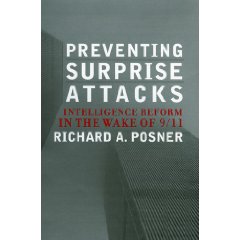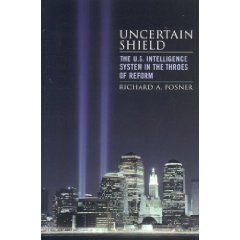
Thoughtful Outside View with Academic Bent,
This, his first of two books disagreeing with the 9-11 Commission focus on centralization, has a number of nuggets worthy of study, but this book is largely oblivious to the many recommendations of both insiders and outsiders who can be considered “iconoclastic.” Judge Posner is an insider, and he draws primarily from “establishment” sources.
He states, I believe correctly, that the Intelligence Reform Act was a “backward step” and provides very professional and detailed support for his view.
The biggest mistake in his view was the refusal to remove intelligence from the FBI culture and create a separate domestic intelligence agency (note: since the Department of Homeland Security has steadfastly refused to do its assigned job of integrating intelligence in support of its mission, Judge Posner can be said to be totally correct in this view).
He posits a fork in the road for the Director of National Intelligence, between engaging in substance and managing the larger enterprise, and appears oblivious to the fact that the Vice President has ordered the DNI to distance himself from the three national agencies captured by the Department of Defense, which are “hands off” in all practical terms.
Judge Posner is at his most articulate and most pointed when he says that the Intelligence Reform Act is a placebo, misleading the public into thinking something has been done, and preventing or lessening focus on other needed defenses including border security, deterrence, and hardening of potential targets.
He noted, accurately, that most of the commissioners were lawyers without an intelligence background, but does not mention that most of them were also compromised (as were senior members of the staff) by ties to the Administrations, precisely what Congress did not want.
He posits a potential role for the Office of Management and Budget (OMB) and this would indeed be a good thing for a future president to consider, but first they would have to put the M back into OMB, as it died over a decade ago.
He brings to bear a familiarity with the literature on organization but not the literature on “organizational intelligence,” nor, as alluded to above, does he appear to have read any of the many works from Allen to Codevilla to Gentry and onwards.
He obsesses on the impossibility of predicting and understanding surprise, while acknowledging that we could do better if we had a *deep* understanding of other cultures that he correctly terms *alien* to our own. Never-the-less, he completely avoids the matter of pre-emptive morally based reduction of incentives to surprise attack and he completely avoids any discussion of the degree to which US budgets and behavior might be aggravating rather than ameliorating the global situation that threatens America.
Chapter 4 is especially valuable, a thoughtful and detailed listing of all of the mind-set, bureaucratic, and other obstacles to intelligence reform that characterize the continually failing secret intelligence environment.
His understanding of open source information (OSIF) and open source intelligence (OSINT) is glib and incomplete. He is still back in the era where CIA defined OSINT as the mainstream media that Foreign Broadcast Information Service (FBIS) could cover in comfort from air-conditioned cubicles in Reston. He appears to have no grasp of the degree to which localized overt collection and distributed leverage of thousands of overt human observers and indigenous experts contribute “real time intelligence” that is legal and ethical (and in languages CIA and FBIS cannot handle).
He suggests that the problem with intelligence is not collection, but rather sense-making. He is half right. For $60B we collect the 5% we can steal and ignore the rest. He is also right that sense-making is the challenge–as the National Imagery and Mapping Agency Commission Report of December 1999 made quite clear, we have invested hundreds of billions in technical collection and next to nothing in tasking, processing, exploitation, and dissemination (TPED). The SAIC failure with NSA's Trailblazer program and the FBI's digitization case file program can be partly blamed on inept government contract management, but the bottom line is that secret processing is dead in the water, withy 80% of the data being “off line” and the processing power now available being marginal.
At the end of the book he raises the issue of “diseconomies of scale” and he is very thoughtful in this regard. He appears to favor a distributed community that can engage in competitive analysis, and I applaud that with one caveat: the intelligence arms of each cabinet department must be fully independent of their policy masters, or “cooking the books” will continue to be the prevailing attribute of the intelligence-policy relationship.



